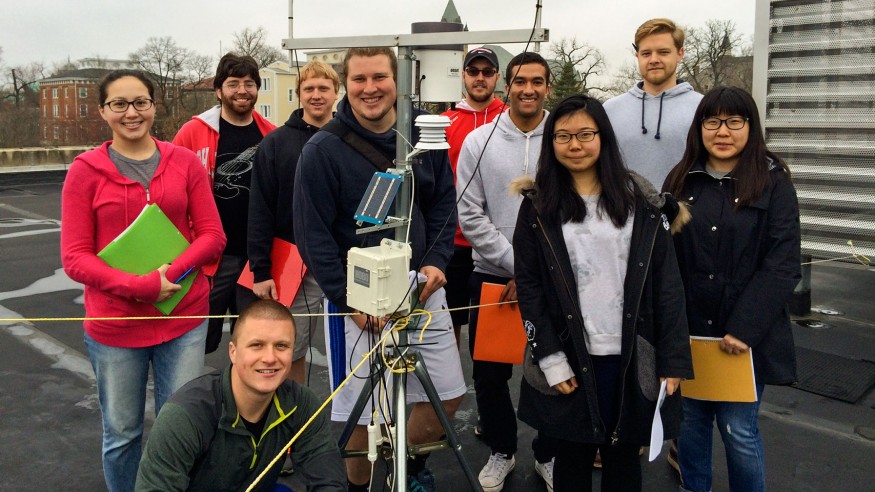
On-Campus Weather Station Enhances Learning Climate
Equipment Allows Ohio Wesleyan Students to Gain Hands-on Meteorology Experience
Ohio Wesleyan University’s on-campus weather station allows students to take measurements of air temperature, relative humidity, precipitation, barometric pressure, solar radiation, and wind speed/direction.
But the professional-grade station enhances the learning climate in others ways, too, says Nathan Rowley, Ph.D., assistant professor of geology and geography, who acquired the weather station for use in his hands-on weather, climate, and climate change course.
“I believe it is essential not only to understand processes but to know how these data are collected, managed, and presented,” says Rowley, who joined the Ohio Wesleyan faculty in 2014.
The weather station allows students to collect data at OWU’s campus and compare it with observations from other local weather stations to relate observations to the “synoptic picture,” or weather across the country. Their efforts enable the students to form a more complex synthesis of weather conditions in Delaware and how they relate to those throughout the United States – and beyond.
Rob Federer ’16, a math major interested in pursuing a career as an actuary in property/casualty insurance, is enthusiastic about the weather course. “It is important to note that the weather station is only one data point for our very large atmosphere,” Federer says. “Because of this, we also use data collected by other meteorological organizations around the world.”
Explaining further, Federer gives this example: “Say I tell you that there are strong southerly winds pushing a low pressure system over the Gulf of Mexico, up onto the mainland toward Ohio. What can we expect if our weather station is telling us that we have high pressure and cold air? ... We can expect warming and rain/snow depending on the temperature.”
Blake Brewer ’16, a geology major and physical geography minor, says the weather station allows hands-on learning, which is the method through which he and many of his classmates learn best.
Students in Rowley and professor John Krygier’s fall Travel-Learning Course, Geography 347: Environmental Alteration, were able to extend their real-world environmental and weather experiences to Costa Rica, when the group traveled to the Bahia Ballena-Uvita region to conduct collaborative research.
The class took water quality and stream discharge measurements, along with collected weather station data to generate an environmental dataset in Delaware during the fall and in coastal Costa Rica in January to better understand how the data relate to regional and global climate and environmental change. The project included work with Amy Work, a 2004 OWU alumna and her community geography organization, Geoporter, located in Bahia Ballena-Uvita.
With Work’s background in geospatial and environmental education, the OWU professors say, she provides a unique opportunity to develop a long-term collaborative project between Geoporter and Ohio Wesleyan.
As for the new weather station, Rowley says, the hands-on work includes having students assemble the weather station on the lawn outside the Schimmel/Conrades Science Center to learn how it works. Then, they take it apart and reassemble it on the rooftop of the science center, where it captures data more accurately.
“I anticipate working to develop a semi-permanent installment of the weather station,” Rowley says, “for research purposes and to provide current weather observations for the OWU community.”
Learn more about the Ohio Wesleyan Department of Geology and Geography at www.owu.edu/geology.
